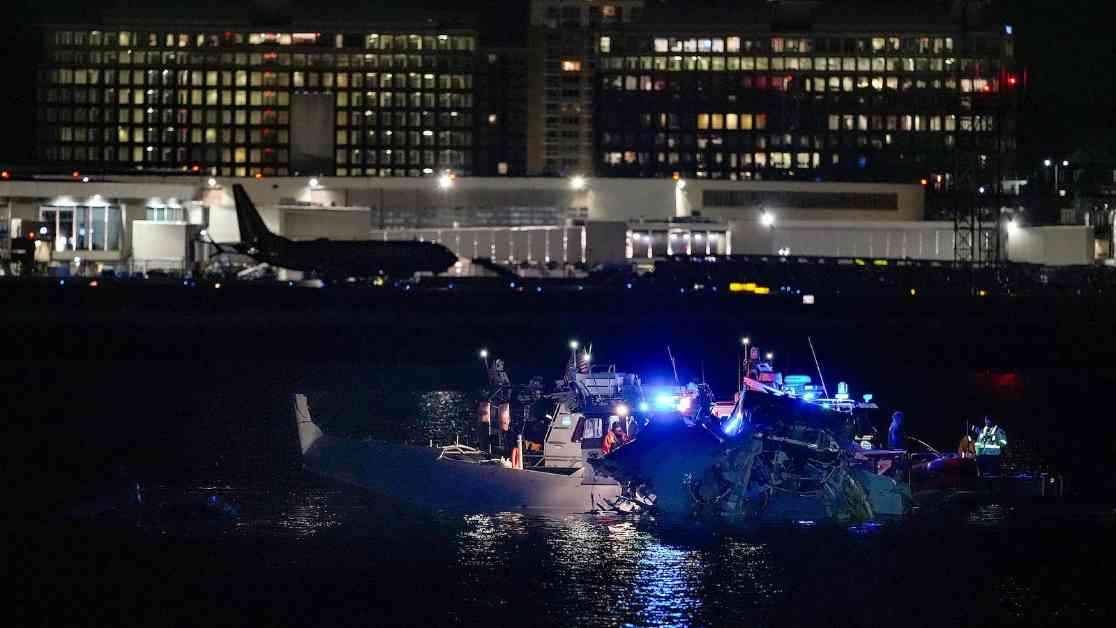An American Airlines regional jet and a U.S. Army Black Hawk helicopter were involved in a tragic mid-air collision near Reagan National Airport, marking the first major commercial airline crash since 2009. The incident unfolded on Wednesday night, prompting a swift multi-agency search-and-rescue mission to locate survivors and assess the extent of the devastation.
The Federal Aviation Administration reported that a PSA Airlines Bombardier CRJ700 regional jet, en route from Wichita, Kansas, collided with the Black Hawk helicopter as they neared the airport around 9 p.m. local time. The collision led to the diversion of 19 incoming flights bound for Reagan National Airport, rerouting them to Dulles International Airport in Virginia for safety.
As the details of the crash continue to unfold, Defense Secretary Pete Hegseth expressed profound sorrow and announced an immediate investigation into the incident. The gravity of the situation was further emphasized by President Donald Trump, who took to social media to question the circumstances that led to the crash, emphasizing the need for accountability and thorough examination of the events that transpired.
In a poignant address, Kansas Senator Roger Marshall lamented the potential loss of life aboard the regional jet and the Black Hawk helicopter. With a heavy heart, he acknowledged the scale of the tragedy, underscoring the immense value of each individual onboard and the devastating impact of such a catastrophic event. The uncertainty surrounding the fate of the passengers and crew only added to the somber atmosphere at the news conference.
Despite the absence of official confirmation regarding fatalities, concerns loom large over the fate of the 64 individuals aboard the jet and the three occupants of the helicopter. As the investigation unfolds, the aviation community and the nation at large await answers, grappling with the sobering reality of lives lost and families forever changed by the tragic collision.
Search and Rescue Efforts Intensify
In the aftermath of the crash, search and rescue operations are in full swing, with emergency responders working tirelessly to locate survivors and treat any injuries incurred during the collision. The coordination of multiple agencies and swift deployment of resources underscore the urgency of the situation, as every moment is critical in determining the outcome of this tragic incident.
As first responders navigate the murky waters of the Potomac River, their efforts are met with challenges and uncertainties, compounded by the darkness of the night and the complexity of the crash site. The resilience and dedication of these individuals shine through as they brave the elements and the unknown, driven by a shared commitment to saving lives and offering solace to those affected by the disaster.
Expert insight from aviation specialists and search-and-rescue teams sheds light on the intricacies of such operations, highlighting the meticulous planning and expertise required to navigate high-stress environments and provide timely aid to those in need. The collaborative nature of these efforts serves as a testament to the unwavering spirit of unity and compassion that defines moments of crisis and underscores the resilience of the human spirit in the face of adversity.
Lessons Learned and Paths Forward
As the nation grapples with the aftermath of the tragic collision, questions arise regarding the root causes of the incident and the steps needed to prevent similar tragedies in the future. The aviation industry faces renewed scrutiny as regulators and industry experts assess the safety protocols and operational procedures that govern air travel, seeking to identify gaps and vulnerabilities that may have contributed to the crash.
Key stakeholders, including government officials, aviation authorities, and industry leaders, converge to address the systemic issues that underpin aviation safety, emphasizing the need for transparency, accountability, and continuous improvement in the pursuit of a safer, more resilient air transportation system. The lessons learned from this devastating event serve as a sobering reminder of the risks inherent in modern aviation and the imperative to prioritize safety above all else.
Moving forward, the nation mourns the loss of life and honors the memories of those who perished in the crash, offering support and solidarity to the families, friends, and communities affected by this tragedy. The resilience of the human spirit shines through in moments of darkness, illuminating the path forward with hope, compassion, and a shared commitment to building a safer, more secure future for all who take to the skies.


